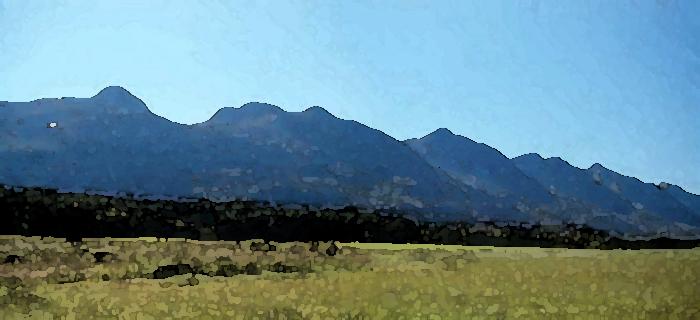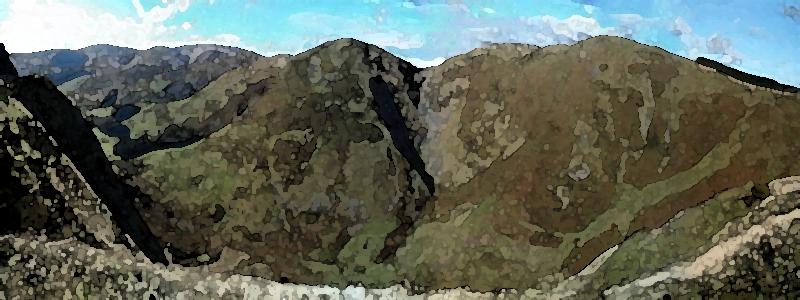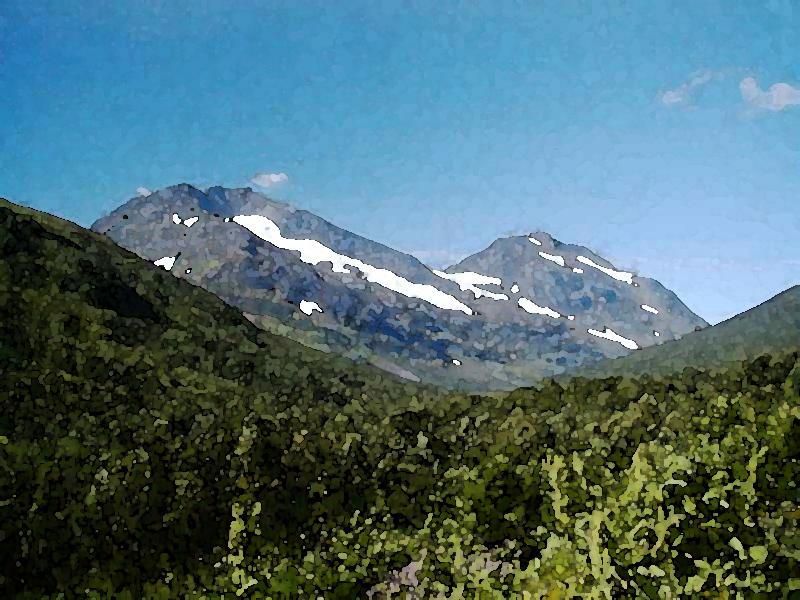 |
Main page |
 |
History |
 |
Geography |
 |
Society |
 |
Stories |
 |
Dunraic Glossary |
 |
Links |
Tolkien tells us very little about the geography of Dunland. We know that northern Dunland was Ďa green and pleasant countryí bordered by the Glanduin (Border River).1 However, the name ĎDunlandí given to the country by the Rohirrim2 conjures up hues of grey and brown. I have therefore made some conjectures regarding the likely terrain, and have also named several settlements and placed them on the map.
Terrain
To the east, Dunland is bordered by the Misty Mountains. This mountain chain may rise as high as 12,000 feet in places,3 though it seems likely that at the southern end of the range the peaks were lower than this. I have placed Dunlandís principal fortress, Caer Goruchel, in a wide valley shadowed by Ban Diwethaf, the Last Peak. The mountain chain continues beyond this, past Isengard to the gap of Rohan, but presumably the summits must have been considerably lower in the southernmost part of the range.
Away from the Misty Mountains, the Atlas of Middle-Earth3 suggests that the terrain can be divided into upland moors and lowland bogs. We know that the ground near the great North–South road was marshy, as long causeways were needed to carry the road to Tharbad.4
The northern border of Dunland was marked by the Glanduin (Border River), also known in its lower reaches as the Swanfleet. This river runs swiftly in its upper courses, before dropping over a set of falls down into the lowlands.1 Beyond this point the river flows sluggishly, creating a fenland, a network of pools and islets inhabited by swans and many other water birds.4
There is only one forested area shown on the map of Dunland, the wood west of the Misty Mountains where, in Lord of the Rings,1 the hobbits and Gandalf met Saruman. There may have been other similar woods in some of the mountain valleys. No specific tree types are mentioned, but pine, birch and rowan would all be appropriate species.
It seems likely that most of the Dunlendings inhabited the mountain valleys, as did their Forgoil neighbours. We know that when the Dunlendings settled in northern Westfold, a province of Rohan, they made their homes in the mountain glens west and east of Isengard.5 The Ďgreen and pleasant countryí of northern Dunland would have been suitable for arable farming. The Dunlendings probably grew oats and barley, and kept sheep and goats in the mountain valleys. The lowland bogs would have produced another useful resource – peat. With wood so scarce, it is likely that peat was used as a source of fuel, and it may even have been exported to the treeless plains of Rohan.
Settlements (south to north)
[Note: Tolkien gives no information about settlements in Dunland, so this is all pure invention on my part.]The triangle of land lying between the Rivers Isen and Adorn, known to Dunlendings as the Dyffryn and to Forgoil as the West-March, has long been debatable land to which both peoples have laid claim. Under the Forgoil administration many folk of Dunlending blood lived in the region, but in Fourth Age 380 they were driven from their homes by a brutal pogrom. Some fled north to the foothills of the Misty Mountains, others south into the Lefui valley in neighbouring Gondor. In Fourth Age 400 the Dunlendings seized the region again, expelling the Forgoil settlers in a violent reprisal. It is unclear now who will settle the region long-term, for there is still hatred on both sides.
The fortress of Caer Goruchel, lying at the mouth of Cwm Hirion, a long mountain valley in the shadow of Ban Diwethaf, has become the administrative centre for Dunland under Forgoil rule. Originally Dunlandís capital was further north, in the old township of Cantynn, but the Forgoil chose to move the seat of power closer to their own land of Rohan. Caer Goruchel is still principally a military stronghold, although a small town has sprung up around the fort itself and the Dunlending peasantry living in Cwm Hirion continue to farm the land as their forefathers have done for generations.
Just to the north-east of Dunlandís most extensive area of woodland, Coed-y-Ffawydd, lies the old market town of Cantynn, Dunlandís former capital and still a thriving centre for trade. A road leads westward from the town to join the Greenway, the old North–South road that links Gondor and Arnor, and many merchants choose to break their journey in Cantynn, perhaps to buy some of Dunlandís wool, mutton or cheese, or even the famous chwisgi, a distilled barley spirit. The town has therefore become Dunlandís largest population centre.
North and east of Cantynn lies a land of rolling hills and broad valleys, the widest of which is Glyn Llydan. The regionís main settlement is Trefgwehyddion, centre for the cloth-weaving industry.
Further north again the mountain peaks become higher and the valleys steep-sided and rocky. Here the land is too poor for arable farming, but the people of the northern valleys, the largest of which are Glyn Eryr and Glyn Arth, are famed as shepherds. The northerners are regarded as somewhat backward folk by the rest of Dunland – a wild people, fiercely loyal to their chieftains and unwavering in their hatred of the Forgoil.
Dunlandís most northerly settlement is the frontier town of Morfeth, located on the windswept moors near to Dunlandís north-eastern border. Because of the townís proximity to the Cloddfeydd Tywyll, the dark mines of Moria, there is often trouble with Orcs, and it is the only settlement in Dunland in which the Forgoil weapons ban was never enforced. Those who choose to live in and around Morfeth do so not for love of the moors themselves, which are bleak and inhospitable, but because the mountains in this region are rich in iron ore. Here is the centre for Dunlandís smithing trade.
Westwards of Morfeth, along the line of the Afon Cyffin (the Glanduin or Border River), lies the green and pleasant region known as Brastir. This is Dunlandís richest arable land, and the best oats and barley are grown here. The area has no major settlements, but is dotted with many small farmsteads.
Maps
An excellent general map of Middle-Earth in black-and-white PDF format can be found at http://www.taylorcustom.com/localinks/mearth/mearthmap.html. I prefer the single-page map with names, as Dunland is across several pages on the larger map.
A more detailed map of Dunland is shown below (click on the map for the full-size version). Non-Tolkien settlements/placenames are shown in grey.
References
1. Tolkien J.R.R., 1955, Lord of the Rings, Book Six, chapter 6 ĎMany Partingsí2. Tolkien J.R.R., 1955, Lord of the Rings, Appendix F ĎOf Mení
3. Fonstad K.W., 1992, The Atlas of Tolkienís Middle-Earth, revised edition
4. Tolkien J.R.R., 1980, Unfinished Tales, Part Two, chapter IV ĎThe History of Galadriel and Celeborní
5. Tolkien J.R.R., 1980, Unfinished Tales, Part 3, chapter V ĎThe Battles of the Fords of Isení
Note:
All pictures are © R. Parks, and have been used with permission. Click on the images to see full-size photographs.




